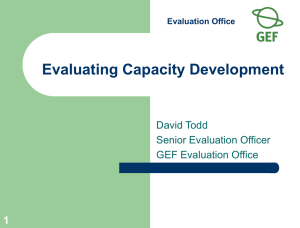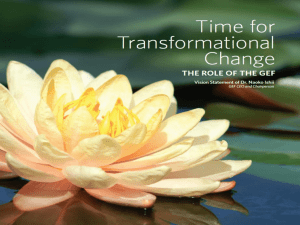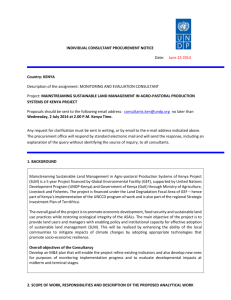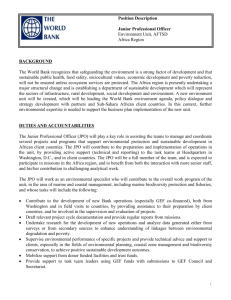THE WORLD BANK/IFC/M.I.G.A. - Global Environment Facility
advertisement
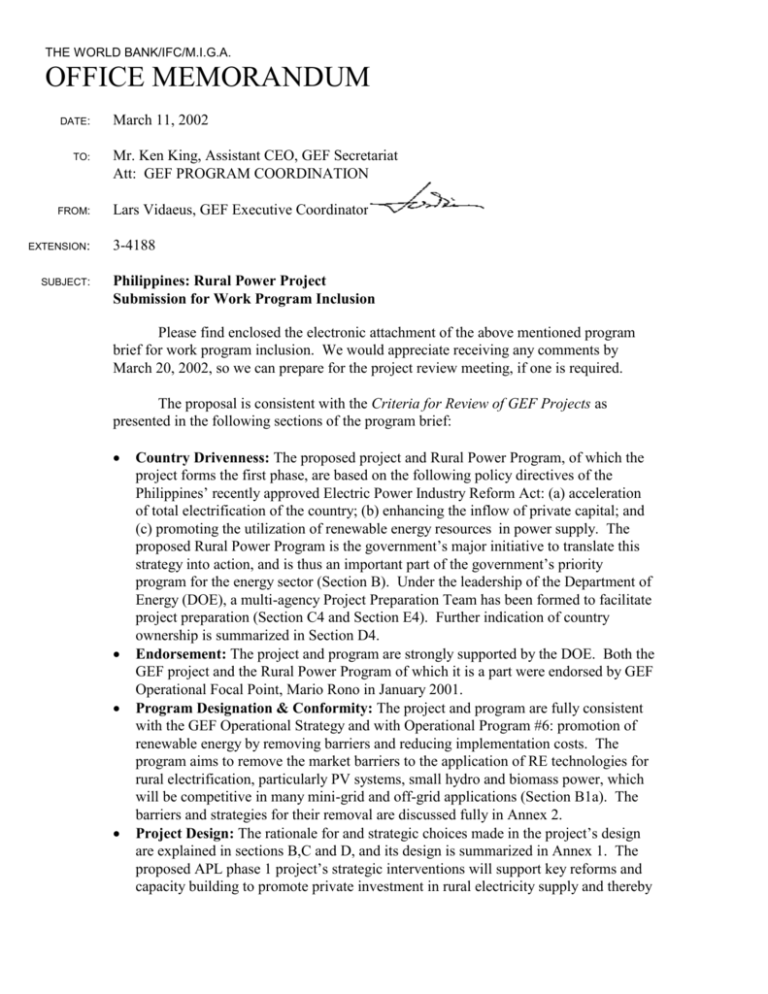
THE WORLD BANK/IFC/M.I.G.A. OFFICE MEMORANDUM DATE: TO: FROM: EXTENSION: SUBJECT: March 11, 2002 Mr. Ken King, Assistant CEO, GEF Secretariat Att: GEF PROGRAM COORDINATION Lars Vidaeus, GEF Executive Coordinator 3-4188 Philippines: Rural Power Project Submission for Work Program Inclusion Please find enclosed the electronic attachment of the above mentioned program brief for work program inclusion. We would appreciate receiving any comments by March 20, 2002, so we can prepare for the project review meeting, if one is required. The proposal is consistent with the Criteria for Review of GEF Projects as presented in the following sections of the program brief: Country Drivenness: The proposed project and Rural Power Program, of which the project forms the first phase, are based on the following policy directives of the Philippines’ recently approved Electric Power Industry Reform Act: (a) acceleration of total electrification of the country; (b) enhancing the inflow of private capital; and (c) promoting the utilization of renewable energy resources in power supply. The proposed Rural Power Program is the government’s major initiative to translate this strategy into action, and is thus an important part of the government’s priority program for the energy sector (Section B). Under the leadership of the Department of Energy (DOE), a multi-agency Project Preparation Team has been formed to facilitate project preparation (Section C4 and Section E4). Further indication of country ownership is summarized in Section D4. Endorsement: The project and program are strongly supported by the DOE. Both the GEF project and the Rural Power Program of which it is a part were endorsed by GEF Operational Focal Point, Mario Rono in January 2001. Program Designation & Conformity: The project and program are fully consistent with the GEF Operational Strategy and with Operational Program #6: promotion of renewable energy by removing barriers and reducing implementation costs. The program aims to remove the market barriers to the application of RE technologies for rural electrification, particularly PV systems, small hydro and biomass power, which will be competitive in many mini-grid and off-grid applications (Section B1a). The barriers and strategies for their removal are discussed fully in Annex 2. Project Design: The rationale for and strategic choices made in the project’s design are explained in sections B,C and D, and its design is summarized in Annex 1. The proposed APL phase 1 project’s strategic interventions will support key reforms and capacity building to promote private investment in rural electricity supply and thereby Mr. Kenneth King -2- March 11, 2002 leverage the government’s limited resources. It will also pilot-test various business models for mobilizing major private sector participation. Lessons learned from previous Bank program operations, from other renewable energy promotions effort world-wide, and from previous GEF and other donor support for renewable energy development in the Philippines are reflected in the design (elaborated in Section D3). Sustainability: The key factors promoting the sustainability in this project are its focus on: (a) developing a policy framework conducive to private sector led and commercially-oriented renewable energy development, while utilizing judiciously designed subsidies to take account of relatively lower rural incomes and affordability; and (b) comprehensive and sustained capacity building of all the key local players, particularly private investors and financiers. The sustainability issues, critical risks and how they will be addressed are summarized in section F and a section in Annex 2. Replicability: APL 1 is explicitly designed to create an enabling policy framework for private investment and to identify viable business models through pilots that will be scaled up and replicated in subsequent phases of the APL. Good practices and lessons learned from this project will also be disseminated to other countries. Stakeholder Involvement: Measures to identify and promote the involvement of key stakeholders, including target beneficiaries, are summarized in Sections C3 and E6.2, while consultations with NGOs and other civil society organizations are summarized in Section E6.3. Monitoring & Evaluation: Monitoring and evaluation of progress toward the achievement of GEF objectives will be part of the overall APL monitoring and evaluation effort. The mechanisms are summarized in Section C4 Institutional and Implementation Arrangements – Monitoring and Evaluation Component, while the indicators are identified in the Project Design Summary (Annex 1). Financing Plan: See Summary Page for Cost and Financing Data. Project components and their financing plan are identified in Sections B4 and C1. Cost-effectiveness: Cost effectiveness analyses will be included in pre-investment studies for the potential mini-grid and off-grid investments to ensure the selection of least-cost options (Section E1). Core Commitments and Linkages: The project is fully consistent with the Philippines CAS and GOP’s development agenda, which places high priority on: (a) acceleration of infrastructure development; (b) enabling private sector participation to improve infrastructure facilities and services, especially in rural areas; and (c) acceleration of environmentally sustainable rural development (Section B1). GEF financing is essential to overcome the information, institutional capacity, high upfront system cost and financing barriers that are critical for the successful implementation of the program’s renewable energy component. Consultation, Coordination and Collaboration between IAs: A major effort has been made to coordinate the program’s design with other donors’ initiatives to ensure complementary rather than overlapping Bank and GEF support to the Philippines. A renewable energy integrator has been appointed at DOE (PHRD funded) specifically to coordinate all donor RE assistance. Regular consultation meetings have been held with other donors during the entire two-year preparation phase to coordinate donor assistance strategies and project assistance. The DOE has ensured and confirmed in Mr. Kenneth King -3- March 11, 2002 writing that the Bank/GEF project is complementary to the UNDP/GEF project that aims to strengthen the capability of the Philippines renewable energy sector in general through various capability building activities (elaborated further in the last part of Section B4 - prepared by DOE - and Annex 2). Response to Reviews: Response to GEFSEC comments (in italic) at the time of pipeline entry: The government should identify how GEF assistance under a WB/GEF project fills gaps in addressing country priorities that are not covered by other existing or proposed renewable energy activities. Response: The gap-filling role of the WB/GEF project is outlined in the Baseline and proposed GEF Alternative summaries in Annex 2. If project includes grid-connected component(s) under a Strategic Partnership, it should explain expected investments (both private and public) and actual policy changes to result from project activities. That is, policy studies by themselves would be an insufficient basis for a grid-connected component of the project. Response: Main-grid connected investment is beyond the scope of this project, although it helps to lay the ground for such a future strategic partnership. The brief should describe the expected benefits and "value-added" that beneficiaries (households and community organizations) will receive, in terms of income-generation, employment, health, education, and productivity. The M&E plan should explicitly monitor and report on these benefits throughout the project. Response: Qualitative benefits of the project are summarized in Section C3 and Annex 2. Quantitative benefits will be estimated by the preinvestment studies and M & E plan will also monitor these aspects (Section A4). Capital cost subsidies for on-grid or mini-grid components are not expected or may be provided in limited amounts commensurate with demonstration potential. Subsidies for SHS or similar household systems should be based on incremental costs and designed according to the following principles (or the brief should justify why the principles must be modified): (a) Subsidies cover no more than the incremental cost as defined by the difference between payments for similar energy services (i.e., kerosene, batteries, candles), and the cost of a solar home system or other alternative technology. (b) The project should demonstrate that there is a declining need for subsidies as costs decline through economies of scale in procurement, service, training, marketing, etc., or through other factors. (c) The project should apply GEF subsidies on a declining scale over the life of the project, such that by the end of the project, there should be no more need for GEF subsidies to enable a sustained market, although on-going government subsidies (i.e., equivalent to those given to grid-connected consumers) may still be part of a "sustained" off-grid market. (d) Incremental costs should be cost shared with other partners whenever possible. This is similar to (c), in that the GEF share of incremental costs should decline to zero by the project end, but the remaining Mr. Kenneth King -4- March 11, 2002 incremental costs may remain if a sustainable mechanism for covering them exists. (e) The project should try to leverage and maximize financing resources from others as a result of the existance of any GEF-provided subsidies. Response: The proposed subsidy scheme will indeed be based on the principles noted above (Annex 2) and detailed design of this scheme will be covered under the ongoing TA for rationalization of subsidies for rural electrification. UNFCCC comments: 1. Under the head of Energy sector background and development, information has been provided for projected energy consumption in 2000. It may be of use to provide actual data for 2000. The project document will also be strengthened bythe discussion of the potential for development of each of these NRE resources at the national level. Response: covered under Annex 2. 2. We would appreciate receiving comments on the fact that the Philippines Energy Plan (1999-2008) projects an increase in renewable energy utilization but a decrease in total contribution in the energy mix as reliance on coal is envisaged to increase. It may be of use to include in the project document the total energy mix and how the project is expected to influence the mix in the future. Response: covered under Annex 2 3. It would be worthwhile if the project document provides some insights into the policy framework in place for deployment of NRE. Along the same lines, a status picture of the Omnibus Electricity Bill and the NRE Bill could be provided, for clarity. Response: Covered under Annex 2 4. In the context of being consistent with national priorities and programs,mention could also be made of the Energy Resources for the Alleviation of Poverty (ERAP) Program which envisages a target of 90 per cent electrification for each barangay by 2004, in contrast to the current value of 72 per cent electrification. The project document refers to the target of the National Energy Plan, on page 3. Is there a link between the National Energy Plan and the ERAP targe?. In light of the new government, it may be useful to comment on whether the ERAP Program will still be implemented; in light of this recent change, the project document may wish to reflect the energy priorities of the new government. Please clarify. Response: The name of the Rural Electrification Program has been changed from ERAP to the O-Ilaw Program, and is still part of the National Energy Plan. The current administration has reaffirmed its priority, and the target schedule for 100% barangay electrification has recently been extended to (still optimistic) 2006. For further information, please see the DOE website (http://www.doe.gov.ph) Mr. Kenneth King -5- March 11, 2002 5. Additionally, while the project document deals with barriers with NRE deployment, what are the specific factors relating to rural RE deployment. Given that this project is primarily focusing on the rural sector, it may be useful to elaborate on the ADB TA project on rural electrification, which relates to capacity building of government institutions and assessing the potential sites for renewable energy projects in rural areas. Response: the ADB TA supported institutional strengthening of the rural electrification players, which facilitated preparation of this project by helping to establish the rural electrification program management office at the DOE. 6. The overall project objectives appear to overlap with the UNDP-GEF and the UNDP-FINESSE projects. Response: The UNDP-FINESSE project is limited to capacity building of one bank, namely the Development Bank of the Philippines (DBP). On the other hand, the capacity building component of this project is proposed to cover a significant number of local financial intermediaries, including Land Bank of the Philippines, rural banks, micro-finance institutions, as well as non-bank participants, such as the participating suppliers of solar pv. The project’s complementarity with the UNDP/GEF project is covered under Annex 2. 7. It may be useful to revisit the activities listed within the project document, on page 9, in light of potential overlap between those identified and other projects. For instance in the case of activities 1-4, the DOE is currently doing these activities utilizing several funds (internal funds of DOE, ADB TA,UNDP-GEF PDF B, and rural electrification funds from energy regulation). There also appears to be an overlap between the activities identified in this project document and that of the UNDP-GEF PDF B project document. Response: covered under Annex 2 8. The Energy Regulation 1-94 sets aside 1 centavo per kW in power generation to environmental protection and electrification of towns and villages hosting power generation facilities. These funds are now being used to conduct feasibility studies and financing of renewable energy projects. Some insights may be provided as to how the WB-GEF PDF B complements these existing efforts. Response: This fund totaled about P130 million or $2.6 million in 2001. The beneficiaries of these funds are mainly the communities hosting power generation facilities. While recent amendment of the regulation allows for broadening the geographical coverage of the beneficiaries, the amount available is very limited and is mainly targeted at small scale, commercially non-viable community based projects implemented by NGOs. 9. The document mentions that there is a lack of funding for the conduct of preinvestment studies. It would be useful to inform if there has been any change in the status of these pre-investment studies due to the numerous ongoing projects. Mr. Kenneth King -6- March 11, 2002 Response: The lack of funding for feasibility studies remains an issue. Currently, DBP is the only local financial institution trained in NRE lending and its credit facility for pre-investment studies is limited to $25,000 per project. 10. The project document does not currently include the estimated global benefits resulting due to the project. Have the incremental costs been studied. From the description of the baseline situation in terms of ongoing and proposed projects it appears as though renewable energy deployment is likely even in the absence of GEF support. Response: covered under Annex 2 UNDP comments call out one project activity and six PDF activities that overlap or duplicate activities in an existing UNDP/GEF full project. PDF activities conducted should first account for any results available from the UNDP/GEF project, and potentially modify PDF activities based on the availability of these results. The brief itself, or a separate memo, should explain how the PDF phase made effective use of outputs available from the UNDP project, and how effective sharing of results will occur under the full WB/GEF project. Response: Covered under Annex 2 Please let me know if you require any additional information to complete your review prior to inclusion in the work program. Many thanks. Distribution: Messrs.: F. Pinto, UNDP A. Djoghlaf, UNEP (Nairobi) K. Elliott, UNEP (Washington, DC) N. Ahmad, ADB M. Gadgil, STAP M. Griffith, STAP (Nairobi) C. Parker/M. Perdomo, FCCC Secretariat cc: Messrs./Mmes. Shum, Cabraal, Farhandi, Broadfield, Terrado, Villaluz, (EAP); Khanna, Wedderburn, Aryal, Johnson (ENV); ENVGC ISC, Relevant Regional Files

